
Feature Article
Requirements on Nutritional Composition and Nutrition Labelling of Infant Formulae
 Will Be Effective on 13 December 2015
Will Be Effective on 13 December 2015
There are a wide range of infant formulae to choose from the market. Consumers often find it difficult to make a purchase decision. To parents, their greatest concern is the health of their babies. Nutrient value is therefore their prime consideration in selecting infant foods. Breast milk is doubtless the best natural food for infants. However, when breastfeeding is not feasible, infant formula is the only processed foodstuff which wholly fulfils the nutritional requirements of infants during the first months of life until the introduction of appropriate complementary feeding. Thus it is necessary to ensure that infant formulae are safe and nutritionally adequate for the health and normal growth of infants.
In October 2014, the Legislative Council completed scrutinising the Food and Drugs (Composition and Labelling) (Amendment) (No. 2) Regulation 2014 with a view to protecting the health of infants and young children. The Amendment Regulation lays down requirements on the nutritional composition of infant formulae and the nutrition labelling of infant formulae, follow-up formulae and prepackaged food for infants and young children. The nutritional composition and nutrition labelling requirements for infant formulae will come into operation on 13 December 2015. The other requirements on the nutrition labelling of follow-up formulae and prepackaged food for infants and young children will take effect on 13 June 2016.
In this issue, we will highlight to readers the requirements to be implemented earlier for infant formulae.
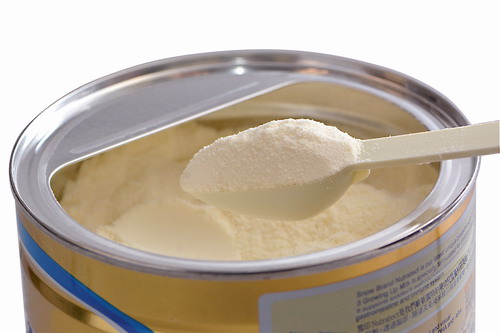
Nutritional Composition: 1+33
Regarding nutritional composition, infant formulae must contain energy and 33 nutrients (i.e. "1+33"). Their energy value and the content of each nutrient must fall within the range specified in the Amendment Regulation.
Taurine, if added to infant formulae, is subject to the maximum level. Furthermore, the ratios of certain nutrients are specified in the Amendment Regulation. For instance, the ratio of calcium to phosphorus must be at least 1:1 and not more than 2:1. If docosahexaenoic acid (DHA) is added, the ratios of arachidonic acid (AA) and eicosapentanenoic acid (EPA) to DHA are also prescribed.
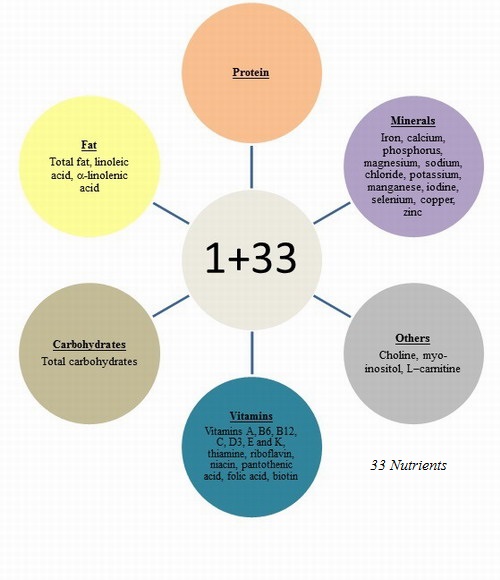
33 Nutrients
Nutrition Labelling: 1+29
As for nutrition labelling, the Amendment Regulation stipulates that infant formulae must label the energy value and the content of 29 nutrients (i.e. "1+29").
Information on other nutrients may be set out on nutrition labels provided that such information is not false, misleading or deceptive in any respect as to the nutritional or dietary value of the product.
Moreover, considering the higher risk of dental fluorosis associated with excessive exposure to fluoride, infant formulae with a fluoride content (in a form that is reconstituted or served according to any instructions for use provided) exceeding 100 µg per 100 kcal or 24 µg per 100 kJ must be marked with a statement indicating that consumption of the formula may cause dental fluorosis.
The formats of nutrition labelling apply to infant formulae. The nutrition information shall be presented in a tabular form in a conspicuous place on the package with an appropriate heading. Such information can be written in Chinese (traditional or simplified), English or both languages. However, if the label of an infant formula product is in both English and Chinese, the nutrition information of the product shall also be set out in both languages.
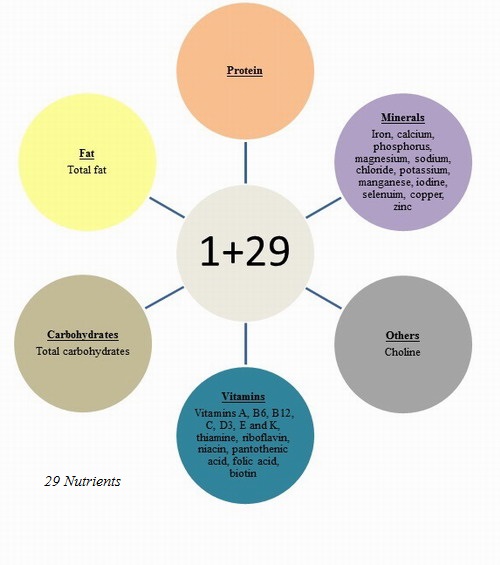
29 Nutrients
We hope that the above introduction can give you a better understanding of the regulation of infant formulae under the Amendment Regulation. With the implementation of the Amendment Regulation, parents can make informed choices about feeding their babies by referring to the nutrition information on the nutrition labels of infant formulae. For food manufacturers/importers, they shall conform to the new requirements by ensuring that infant formulae for sale are in compliance with the nutrition standards and that accurate nutrition information is available.
Readers' Corner
Have Poultry on The Market Received Hormones?

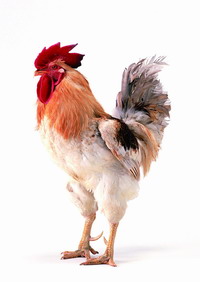
There are lots of rumours about foods that may give rise to diseases, such as "eating hormone-injected chickens can cause cancer". It is said that unscrupulous chicken farmers will inject hormones into their flocks to speed up their growth and increase profits. If we eat these chickens, we are at higher risk of developing breast cancer due to elevated oestrogen levels. Is this true?
In fact, synthetic oestrogen hormones, including stilbenes like diethylstilboestrol (DES) and hexoestrol, were used by the poultry industry in the 1950s. However, DES was considered carcinogenic to humans by the International Agency for Research on Cancer in its evaluation in 1987. Nowadays, the use of stilbenes (including DES) in poultry is banned in places like Hong Kong, Mainland China, Australia, the European Union and the United States.
As a usual practice, government departments have been collecting samples from local poultry farms, as well as at import, wholesale and retail levels, for testing of stilbenes to ensure that poultry and poultry products are safe for consumption.
Advice to the Trade
- To purchase poultry and poultry products from reliable suppliers.
- Not to use stilbenes in poultry and to be familiar with relevant regulations to ensure poultry and poultry products sold are fit for human consumption.
Hepatitis A and Food

Locally, there has been an increase in hepatitis A cases this year. The number of cases reported in the first quarter has nearly reached the total recorded in the previous year. Hepatitis A is caused by hepatitis A virus (HAV), which can lead to inflammation of liver cells. Affected persons may be asymptomatic. Those who have symptoms may suffer from loss of appetite, fatigue, nausea, vomiting, diarrhoea, fever, upper abdominal discomfort, jaundice (yellowing of the skin and the whites of the eyes) and have dark urine.
The outbreak of hepatitis A may be associated with the consumption of raw/undercooked shellfish (e.g. oysters) or contaminated fresh fruits/vegetables (e.g. berries). HAV is excreted in the faeces of infected persons, hence the virus can contaminate water and food. As shellfish live in water and filter feed on aquatic microorganisms, they are prone to HAV contamination. Berries, which are commonly consumed raw, may also be contaminated with HAV if they have been irrigated with polluted water. If people eat these contaminated and undercooked foods, they may fall victim to hepatitis A. HAV, moreover, can be transmitted through cross contamination of food, or when food is handled by HAV carriers negligent in personal hygiene.
By practising the "Five Keys to Food Safety", we can effectively prevent foodborne spread of hepatitis A. To minimise the risk of HAV infection, members of the public should observe personal hygiene and good hygiene practices in food preparation to prevent cross contamination.
Advice to the Trade
Purchase:
- To obtain food from approved and reliable shops.
- To choose fresh and wholesome food and check the quality of the ingredients upon receiving them.
Storage:
- To store raw food and cooked or ready-to-eat food in separate refrigerators. Do not overstuff refrigerators.
- If raw food and cooked or ready-to-eat food are to be kept in the same refrigerator, put them in separate lidded containers and place raw food below cooked or ready-to-eat food.
Preparation:
- To use separate utensils to handle raw food and cooked or ready-to-eat food. To wash the utensils with hot water and detergent after each use.
- To scrub and rinse shellfish with clean water and remove the internal organs. Shellfish with broken shells should be discarded.
- To cut raw meat and offal into thin slices to allow thorough cooking.
- When making salads with fresh fruits, wash the ingredients thoroughly with drinking water. Take note that HAV on fruits cannot be completely eliminated by washing. The control on HAV in fresh produce therefore lies in prevention of contamination.
Cooking:
- To cook food thoroughly. The juices of cooked meat and offal should be clear, not red. Blood should not be visible when cooked meat and offal is cut.
- Heating to an internal temperature of 90°C for 90 seconds is required when handling shellfish. If possible, remove the shells before cooking. Otherwise, boil the shellfish at 100°C until their shells open, and boil for another three to five minutes afterwards. Shellfish that do not open after cooking shall be discarded.
Personal Hygiene:
- To wash your hands under running water with soap before handling food, after handling raw meat or poultry, and before food consumption. Always begin food preparation by washing your hands and rub them for at least 20 seconds.
- To stop handling food when you have contracted or are suspected to have contracted an infectious disease, or when flu-like symptoms, diarrhea, vomiting, jaundice, fever, sore throat and abdominal pain occur.
By applying the "Five Keys to Food Safety" to purchase, storage, preparation and cooking of food, most foodborne diseases (including hepatitis A) can be prevented.
News on New Dishes
Spaghetti with Ox Tongue in Light Curry Sauce
When we talk about the city's food culture, we cannot leave out Hong Kong style cafes, which is a unique combination of Chinese and Western catering. Hong Kong people are well known for their good sense for trends. Can these cafes, best representing Hong Kong, demonstrate the same by keeping pace with the healthy eating trend of reducing salt and sugar intake in recent years? In this issue, we are pleased to have an interview with the operators of "Windows Cafe", a Food Safety Charter signatory in the Islands District. We have also invited their chef, Mr Wilson CHEUNG Shu-fun, a veteran cook with over 20 years of culinary experience, to give a demonstration on how to prepare the dish "Spaghetti with Ox Tongue in Light Curry Sauce".

| Preparation Steps | Small Tips, Big Wisdom | ||
|---|---|---|---|
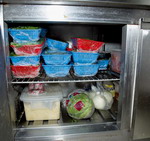 |
Receiving | Purchase frozen ox tongue, vegetables and other ingredients from approved and reliable suppliers. | Upon receipt of the ingredients, check carefully to ensure their freshness. Keep vegetables under refrigeration at 4ºC and store the ox tongue in a freezer at -18ºC for later use. |
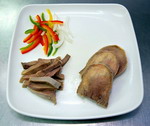 |
Rinsing | Defrost the frozen ox tongue under running water. Vegetables should be soaked and rinsed thoroughly. | A quick way to thaw frozen food is to use running water. This can prevent bacterial growth due to prolonged storage of food at room temperature or in the temperature danger zone. Rinsing vegetables under running water or soaking them in water can effectively reduce the risk of pesticide intake. |
 |
Cooking | Simmer ox tongue in boiling water for about 1.5 hours until tender. Remove the skin and cut ox tongue into slices. Blanch spaghetti and other ingredients such as tri-colour bell peppers and onion separately until done. Drain well and set aside. | Blanching makes it easy to cook food ingredients thoroughly. It can also shorten the time for stir-frying in wok in the final step. |
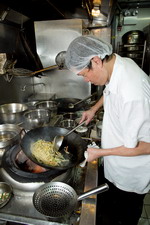 |
Stir-frying | Put coconut milk, chicken stock, a pinch of salt and curry paste in wok and bring to boil. Next, return the cooked ox tongue, spaghetti and other ingredients like tri-colour bell peppers and onion to wok. Stir-fry until blended and ready to serve. | Brisk stir-frying in wok ensures that ingredients are cooked thoroughly and their flavours are enhanced. |
Tips from Chef CHEUNG:

- To ensure that the food ingredients ordered are hygienic and safe, "Windows Cafe" purchases ingredients from reputable and licensed food suppliers. Orders are placed according to daily consumption to ensure freshness.
- Upon receipt of food ingredients, the staff will immediately check whether they are in order. If the quality is unsatisfactory, the restaurant will inform the suppliers for follow-up action.
- After receiving and checking the ingredients, store them in a suitable environment. For example, frozen ox tongue should be placed in a freezer at -18oC or below, while dry goods such as spaghetti should be kept in a hygienic and dry storage place.
- A quick way of thawing frozen ox tongue is to put it under running water. This not only ensures food safety but also keeps its fresh taste. The defrosted ox tongue should be simmered in boiling water until tender. This can shorten the time for the final step of stir-frying in wok with oil at a high temperature. By following the above steps, we can prepare a delicious dish and eat safely and healthily.
Food Safety Plan Corner
Spaghetti with Ox Tongue in Light Curry Sauce
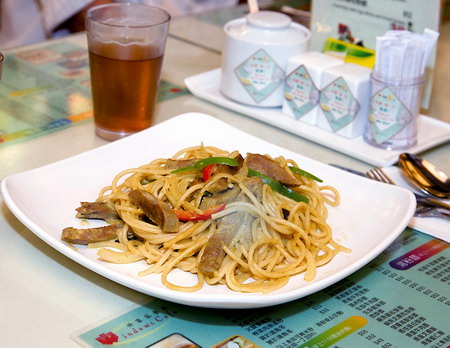
Ingredients:
Ox tongue, spaghetti, tri-colour bell peppers and onion
Sauce:
Coconut milk, curry paste and chicken stock
Steps:
- Defrost the frozen ox tongue under running water.
- Soak tri-colour bell peppers and onion in water, rinse thoroughly and shred. Set aside.
- Simmer ox tongue in boiling water for about 1.5 hours until tender. Remove the skin and cut ox tongue into slices.
- Blanch spaghetti, tri-colour bell peppers and onion separately until done. Drain well and set aside.
- Put coconut milk, curry paste and chicken stock in wok and bring to boil.
- Return the cooked ox tongue, spaghetti and other ingredients such as tri-colour bell peppers and onion to wok. Stir-fry thoroughly and ready to serve.
Production Process
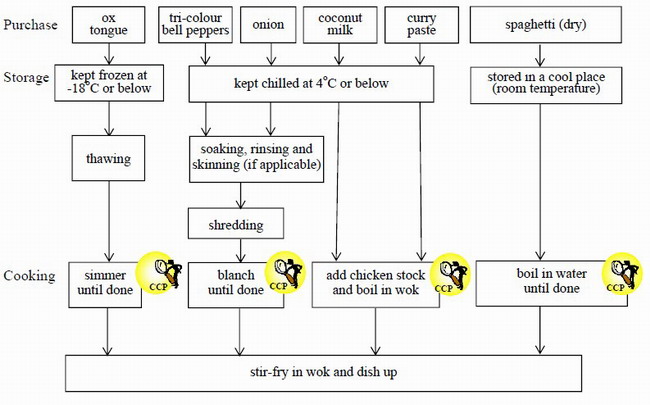

Briefing of Activities
The 2 7th HKTDC Food Expo - Food Hygiene Talk on "Hong Kong's Action on Salt and Sugar Reduction"
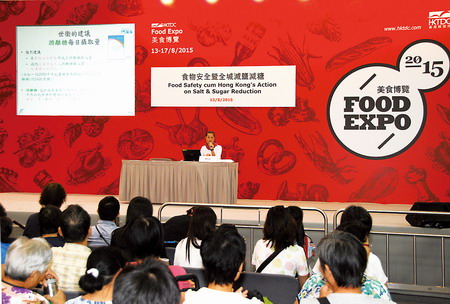
The Food Expo organised by the Hong Kong Trade Development Council is one of the most popular major annual events in Hong Kong. The 27th Food Expo running from 13 to 17 August 2015 has come to a successful end. As in previous years, the Centre for Food Safety (CFS) felt privileged to have taken part in the event. This year's theme was "Hong Kong's Action on Salt and Sugar Reduction". To echo the theme, CFS organised a talk during the Expo to disseminate the message, giving detailed information on reading and understanding nutrition labels, as well as choosing food items with lower salt/sugar content. The talk encouraged the public to change eating habits by adding less seasonings to food to avoid excessive dietary intake of salt/sugar. CFS also took this opportunity to promote the "Five Keys to Food Safety" and introduce some practical tips to the general public on proper food handling to prevent foodborne diseases.
CFS would like to express its heartfelt thanks to all attendees for their keen support.
Upcoming Activities
Thematic Exhibitions And Food Hygiene / Food Safety Talks Organised by Communication Resource Unit
The Communication Resource Unit (CRU) under the Risk Communication Section of CFS maintains a rich collection of food safety materials. It serves the public and the food trade by providing information and advice to help them make healthy food choices and supply safe foods. Located in the city centre, CRU houses an exhibition hall and public and trade corners equipped with audio-visual facilities to enable consumers to gain a better understanding of food safety information in Hong Kong. The exhibition hall stages displays on diverse themes, including nutrition labelling, trans fat, organic food, genetically modified food, natural toxins in food, etc. The exhibits are updated on a regular basis. Please visit the CFS website at www.cfs.gov.hk for information on recent exhibitions.
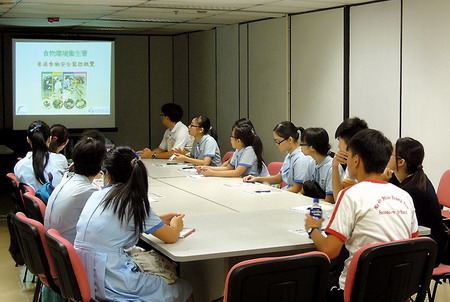
Members of the public wishing to enhance their food safety knowledge are welcome to visit CRU at 8/F., Fa Yuen Street Municipal Services Building, 123A Fa Yuen Street, Mong Kok during office hours from 8:45 a.m. to 1:00 p.m. and 2:00 p.m. to 5:30 p.m., Mondays to Fridays. For group visits to CRU or collective registration for food hygiene or food safety talks, please download the registration form from the website of CFS for arrangements.
Food Safety Q&A
What Points To Note When Consuming Shellfish?
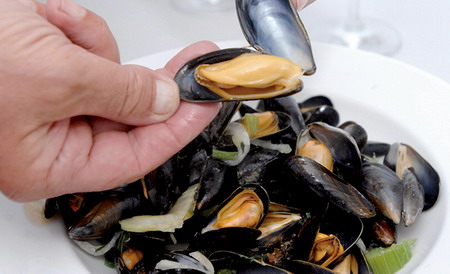
Shellfish (e.g. oysters, clams and scallops) are filter feeders which catch plankton and absorb their nutrients through filtering sea water. In polluted waters, shellfish are likely to have accumulated pathogens, viruses, phycotoxins and metallic contaminants. If we eat contaminated seafood by mistake, food poisoning can occur, even resulting in deaths.
To reduce the risk of food poisoning associated with the consumption of shellfish, we should keep the following points in mind:
- To purchase shellfish from licensed sales locations with a good reputation.
- Raw shellfish should be well packed and stored in the lower compartment of the refrigerator at or below 4ºC, while cooked and ready-to-eat foods should be kept in the upper compartment, in order to prevent shellfish juices from dripping onto these foods.
- Poisonous shellfish neither look, smell nor taste different from uncontaminated shellfish. Phycotoxins are very resistant to heat and cannot be destroyed by cooking. Since these toxins are mainly found in shellfish viscera, it is advisable to remove the viscera and gonads of shellfish whenever possible before cooking. Moreover, the liquids left after cooking shellfish should be discarded before food consumption.
- To cook shellfish in boiling water and keep boiling them for three to five minutes after the shells have fully opened, so as to reduce the risk of microbiological contamination.
- In general, low levels of dietary exposure to heavy metals will not affect human health, but prolonged intake of foods containing heavy metals can be detrimental to health. To avoid excessive intake of contaminants, members of the public should maintain a balanced and diversified diet.
- Young children, elderly persons, pregnant women and people with weakened immune systems should be particularly cautious when consuming shellfish.
Truth Against Fallacy
Is Smoked Salmon Cooked Or Raw?
Whether smoked salmon is cooked or raw is a question extensively discussed on the Internet. To answer it, we need to know how smoked salmon is prepared first.
Smoked salmon has been cured with salt, then smoked hot or cold prior to slicing and vacuum packaging. During hot smoking, salmon is smoked at a temperature of 70-80oC until fully cooked. In the cold smoking process, salmon is smoked at no higher than 33oC to avoid cooking the flesh or coagulation of protein. Unlike hot smoking, cold smoking can only reduce pathogenic bacteria and is generally inadequate for complete sterilisation.
Most smoked salmon found in supermarket freezers or served cold on the buffet table is cold-smoked salmon. It is not thoroughly cooked at cold smoking temperatures and is regarded as a raw food, i.e. it contains pathogenic bacteria or parasites which have not been eliminated. Moreover, cold-smoked salmon is usually vacuum packed. As it is stored under refrigerated conditions in the absence of oxygen, it facilitates the growth of facultative anaerobes (e.g. Listeria monocytogenes ) and anaerobes (e.g. Clostridium botulinum ). Hence cold-smoked salmon poses a higher food safety risk than hot-smoked salmon. For safety's sake, CFS advises that high-risk individuals (including the elderly, young children, pregnant women and immunocompromised persons) avoid consuming cold-smoked salmon.
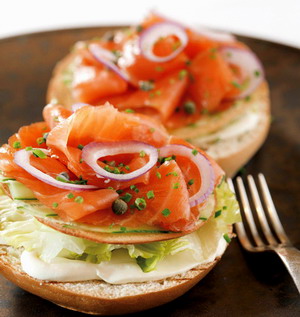
Brain Gym
Question: Which of the following prepackaged foods are exempted from nutrition labelling?
Photo 1: Mineral water
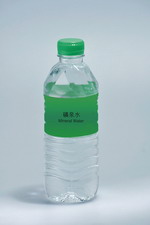
Photo 2: Buns in twist tied bag
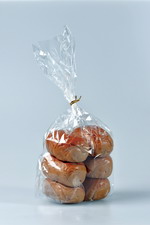
Photo 3: Canned drink with 0.6% alcoholic content
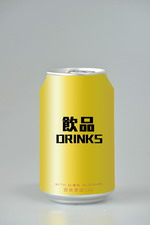
Photo 4: A box of eggs

Photo 5: Prepackaged food as shown
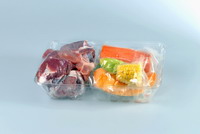
Answer:
Figure 1: Exemptible
Figure 2: Non-exemptible
Figure 3: Non-exemptible
Figure 4: Exemptible
Figure 5: Exemptible
Enquiries and Subscription
Printed copies of Food Safety Express can be obtained from CRU at 8/F., Fa Yuen Street Municipal Services Building, 123A Fa Yuen Street, Mong Kok, Kowloon. For enquiries, please call 2381 6096. Members of the public may also visit the CFS website (www.cfs.gov.hk) for the online version.
| Enquiry hotline | 2868 0000 |
|---|---|
| E-mail address | enquiries@fehd.gov.hk |
| CFS website | www.cfs.gov.hk |